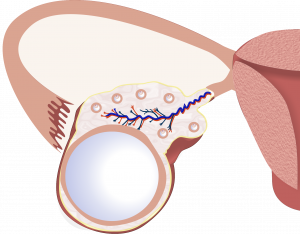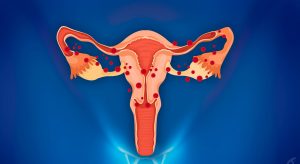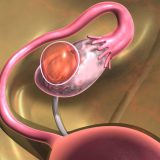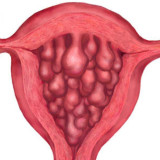The ovarian cyst can sound scary. Everyone has heard about it, but most women do not know what types of ovarian cysts are there and where they come from. Fortunately, the most common type of ovarian cyst – functional cyst – is a benign tumor that does not brings much danger. This cystic alveolar or yellow body cavity has mainly hormonal reasons.
Ovarian cyst occurs when serous fluid accumulates in a thin membrane inside the ovary or on its surface. It may be small in size – like a seed of peas, but also occurs in much larger sizes.
In most cases, ovarian cyst is harmless, but its changes should be regularly monitored. This allows to remove it in time, if necessary, and prevent cancer.
Ovarian cyst is most common in the reproductive period, but can occur in women of all ages.
Although ovarian cyst is a common disease, it is still not fully understood. There are still open questions the answers for which scientists and doctors still look for. At the same time, ovarian cysts treatment is already not a big difficulty and is successfully carried out almost always.
One of the open questions is the cause of ovarian cysts. It is not known exactly why it occurs. Gynecologists usually say it is hormonal disorders, less often blame inflammations.
Types of ovarian cysts
However, we already know a lot about the types of ovarian cysts. There are two main types of ovarian cysts: functional and neoplastic.
Functional ovarian cyst
This type of cyst usually affects women of childbearing age. Their appearance is the result of abnormal hormonal changes that occur during the menstrual cycle.
Follicular cyst. With normal ovulation, the follicle matures and releases the ovule that is ready for fertilization. However, it may happen that the follicle is not rupture, but only grows even more. This leads to a follicular cyst formation.
A cyst of the corpus luteum (luteal). During normal work of the reproductive and hormonal systems, after follicle releases the ovule, it turns into corpus luteum. Then it disappears if there is no fertilization. However, if it does not disappear, then a cyst is formed.
These types of ovarian cysts are often observed by doctors throughout the disease, because the tumors tend to disappear themselves within a few menstrual cycles. In some cases, hormonal treatment is recommended.
Also in this classification can be identified polycystic ovaries. This is one of the types of ovarian cysts that occurs when immature follicles turn into tiny cysts. Unlike the previous two cases, the treatment of this cyst type lasts for many years and is carried out using hormonal drugs. They should stop the new cysts formation and reduce the volume of the ovaries.
Neoplastic ovarian cyst
These types of ovarian cyst are less associated with the menstrual cycle and are more dangerous. Doctors recommend to remove them surgically. The tumors are usually bilateral, can grow up to 15-20 cm in diameter.
Endometrial ovarian cyst (of endometrioma). Also called a chocolate cyst. It is rather common problem among neoplastic types of ovarian cysts. The cysts are filled with dark bloody material. It’s the brown endometrium. Hence the name “chocolate”. They usually develop in women with endometriosis.
The disease, called endometriosis, is that fragments of the mucous membrane are separated and move throughout the body. They can also get into the ovaries, where they turn into chocolate cysts.
The most common symptoms are pelvic or groin pain, severe pain during intercourse, and lower back pain during menstruation. It may also be accompanied by infertility and dysmenorrhea, but many of the patients have no symptoms at all.
The cyst is dangerous because it can burst and its contents will pour into the abdominal cavity. This can lead to peritonitis.
Treatment depends on the size of the tumor, the severity of endometriosis, the severity of symptoms and whether the child is planned in the future. Most often these cysts are removed with surgery.
Dermoid cyst of the ovary. They make up about 25% of all the types of ovarian cysts. In 10-15% of the cases they occur on both sides. About 1-2% of these cysts can turn into a malignant cancer.
An ovarian dermoid cyst is a closed cavity that contains fat cells, skin cells, hair, or even teeth. It usually grows slowly, but under certain conditions, this ovarian cyst begins to spread to the cells of other tissues.
The doctor decides on the treatment of these cysts in each case individually. In most cases, surgery is required. As a rule, laparoscopy is used.
Serous cyst or cystadenoma. These cysts develop from ovarian tissue. Their cavity filled with fluid or mucus, and the epithelial cavity tissue is quite dense. A serous cyst can be simple or papillary.
A simple serous cyst has smooth walls with a smooth contour. The surface of the papillary cyst is covered with growths, similar to dense nodules – papules.














